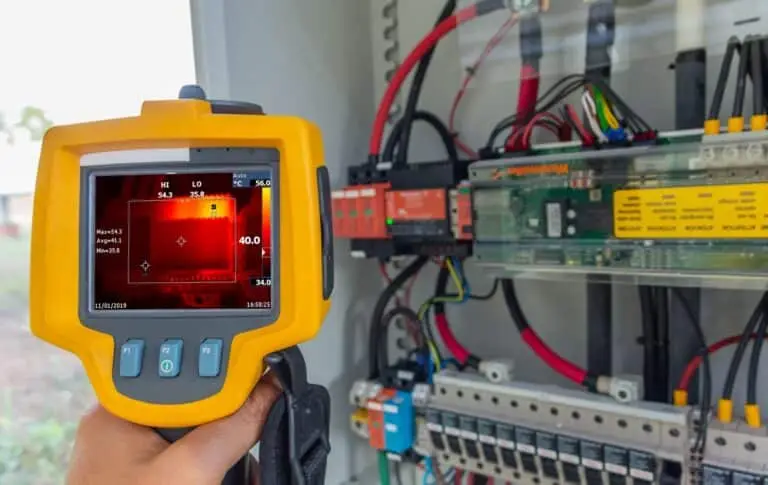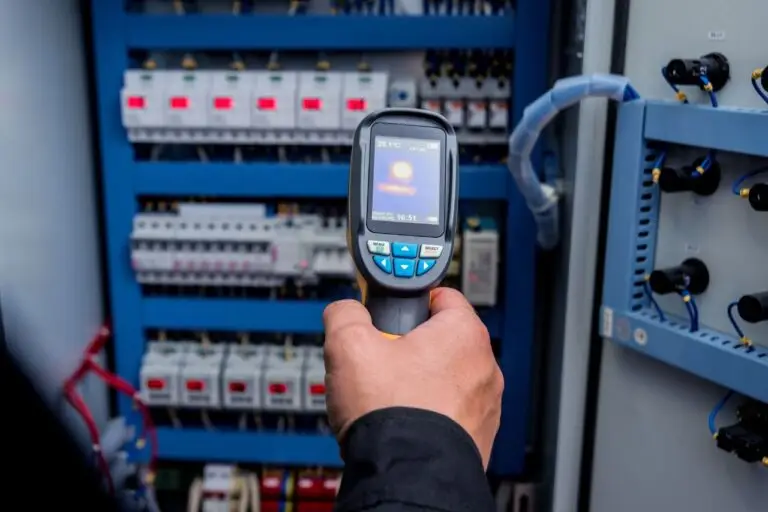What Is Infrared Thermography?
When it comes to electrical maintenance, there’s no one-size-fits-all solution. Annual Infrared Thermography is required by NFPA 70B because it’s an effective and non-disruptive predictive tool —but it’s most effective when used in the right context.
This method is best at detecting heat-related issues like overheating components, load imbalances, and faulty connections—it’s non-disruptive, fast, and ideal for spotting problems before they escalate.
Why is it Important?
Infrared thermography offers a proactive solution to electrical system maintenance with the following advantages:
- Prevent Downtime: Predicts and prevents unexpected system failures, reducing costly downtime.
- Early Detection: Identifies hidden issues such as loose connections, overloaded circuits, and insulation breakdowns.
- Safety & Compliance: Ensures compliance with industry standards like NFPA 70B to enhance workplace safety.
- Optimize Efficiency: Extends the lifespan of electrical components and improves system efficiency.
- Maintain Operations: Inspections are conducted while equipment's are energized so no interruption to services are required
How it Works?
Our certified technicians utilize advanced thermal imaging cameras to scan your equipment while it’s operational. This non-invasive process allows for the identification of anomalies without interrupting your operations. After the scan, we provide a comprehensive report featuring thermal images and actionable prioritized recommendations to address any detected issues.
Is Infrared Thermography Right for Your System?
This method is best at detecting heat-related issues like overheating components, load imbalances, and faulty connections—it’s non-disruptive, fast, and ideal for spotting problems before they escalate.
Primary Function
Detects heat emissions from electrical faults.
Best for Detecting
Overheating components and load imbalances.
Detection Range
Primarily detects surface-level temperature variations
Environmental Impact
Works effectively even in no-contact scenarios.
Equipment Required
Thermal imaging cameras
Limitations
Only detects heat.
Compare Infrared Thermography Testing with other electrical Predictive Maintenance methods
FAQs
What Causes Electrical Equipment to Overheat?
Electrical equipment can overheat due to several factors, including loose or corroded connections, which create high resistance and excessive heat buildup. Overloaded circuits and unbalanced loads force equipment to operate beyond its capacity, increasing the risk of failure. Insulation breakdown can cause short circuits, while poor ventilation and dust accumulation restrict heat dissipation, trapping excessive warmth inside components. Failing components, such as aging breakers or transformers, may also generate abnormal heat patterns. Routine infrared inspections help detect these issues early, reducing the risk of equipment failure and costly downtime.
Is Infrared Thermography mandatory?
Yes, according to the 2023 update of NFPA 70B, infrared thermography inspections are now mandatory for all electrical equipment at least once every 12 months. Equipment classified under “Physical Condition 3,” which includes items where urgent actions were identified in previous scans, must be inspected every six months.
Is the process disruptive to operations?
No, infrared thermography is a non-disruptive process. It allows for the inspection of electrical without requiring equipment shutdowns, ensuring that operations continue uninterrupted during the assessment.
What equipment should be included in the test?
Infrared thermography inspections encompass a broad range of electrical and mechanical equipment to ensure comprehensive system reliability and safety. Key components typically included in these assessments are Switchgear, Motor Control Centers (MCCs), Distribution Panels, Disconnects, Branch Circuit Panels, Bus Ducts, Transformers, etc.
Where does C&H Electric provide its services?
C&H Electric focuses on supporting key facilities across Connecticut USA, including Government Facilities, Healthcare Institutions, Schools, Industrial Plants, Commercial Properties, etc.




